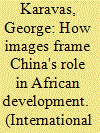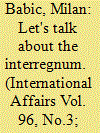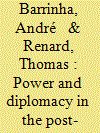|
|
|
Sort Order |
|
|
|
Items / Page
|
|
|
|
|
|
|
| Srl | Item |
| 1 |
ID:
172554


|
|
|
|
|
| Summary/Abstract |
When powerful liberal democratic states are found to be complicit in extreme violations of human rights, how do they respond and why do they respond as they do? Drawing on the example of the United Kingdom's complicity in torture since 9/11, this article demonstrates how reluctant the UK has been to permit a full reckoning with its torturous past. We demonstrate that successive UK governments engaged in various forms of denial, obfuscation and attempts to obstruct investigation and avoid accountability. The net effect of their responses has been to deny the victims redress, through adequate judicial processes, and to deny the public adequate state accountability. These responses are not simply aimed at shielding from prosecution the perpetrators and those who have oversight of them, nor preventing political embarrassment. The various forms of denial and obstruction are also designed to ensure that collusion can continue uninterrupted. A core concern of intelligence officials and ministers has been to prevent any process that would lead to a comprehensive prohibition on involvement in operations where torture and cruel, inhuman and degrading treatment are a real possibility. The door remains wide open, and deliberately so, for British involvement in torture.
|
|
|
|
|
|
|
|
|
|
|
|
|
|
|
|
| 2 |
ID:
172559


|
|
|
|
|
| Summary/Abstract |
While China and Russia's general policies towards the Responsibility to Protect (R2P) are similar, the two reveal nuanced differences in addressing specific emergencies. Both express support for the first two pillars of R2P while resisting coercive intervention under its aegis, as they share anxieties of domestic political security and concerns about their international image. Nonetheless, addressing cases like the Syrian crisis, Russian statements are more assertive and even aggressive while Chinese ones are usually vague and reactive. This article highlights the two states’ different tones through computer-assisted text analyses. It argues that diplomatic styles reflect Russian and Chinese perceptions of their own place in the evolving international order. Experiences in past decades create divergent reference points and status prospects for them, which leads to their different strategies in signalling Great Power status. As Beijing is optimistic about its status-rising prospects, it exercises more self-restraint in order to avoid external containments and is reluctant to act as an independent ‘spoiler’. Meanwhile, Moscow interprets its Great Power status more from a frame of ‘loss’ and therefore is inclined to adopt a sterner approach to signal its status. Although their policies complement each other on many occasions, there is nothing akin to a Sino–Russian ‘bloc’.
|
|
|
|
|
|
|
|
|
|
|
|
|
|
|
|
| 3 |
ID:
172551


|
|
|
|
|
| Summary/Abstract |
World politics generates a long list of anxiety-inspiring scenarios that threaten to unravel everyday life with sudden and violent destruction. From total war and the concentration camps, through nuclear firestorms, global pandemics and climate disaster, the diabolical violence of the recent past and conceivable future is the stuff of nightmares. Yet International Relations scholars and practitioners are often criticized for being disconnected from the human realities of international calamity. The challenge for both is to engage world politics in a way that foregrounds the human consequences of extreme violence and depravation. In this article, we explore these difficult experiences through popular culture representations of the apocalypse, a subject of intense interest for researchers in a discipline where global destruction is a distinct possibility. However, we take a different route by engaging the apocalypse through the horror genre, the one place where human suffering is explicitly accentuated. We argue that the horror genre is at once an access point for ethical engagement with the human consequences of extreme violence and a complex terrain where dark imaginings can be politically loaded, culturally specific and ethically ambiguous.
|
|
|
|
|
|
|
|
|
|
|
|
|
|
|
|
| 4 |
ID:
172553


|
|
|
|
|
| Summary/Abstract |
Political leaders, policy-makers and academics routinely refer to development as an objective process of social change through the use of technical, value-free terms. Images of poverty and inequality are regularly presented as evidence of a world that exists ‘out there’ where development unfolds. This way of seeing reflects the value of scientific forms of knowledge but also sits in tension with the normative foundations of development that take European modernization and industrialization as the benchmark for comparison. The role images play in this process is often overlooked. This article argues that a dominant mode of visuality based on a Cartesian separation between subject and object, underpinning the ascendance of European hegemony and colonialism, aligns with the core premises of orthodox development discourse. An example of how visual representations of development matter is presented through images of Africa–China relations in western media sources. Using widely circulated images depicting China's impact on African development in western news media sources as an example of why visual politics matters for policy-making, the article examines how images play a role in legitimizing development planning by rendering associated forms of epistemological and structural violence ‘invisible to the viewer’.
|
|
|
|
|
|
|
|
|
|
|
|
|
|
|
|
| 5 |
ID:
172546


|
|
|
|
|
| Summary/Abstract |
Visuals are powerful mediators of global political events. Images, moving and still alike, are significant objects that play a role in shaping our understanding of international affairs. Through their multiple interpretations, these visuals can both represent reality and condition how we understand it. Within International Relations, there has been growing attention to the visual, with explorations of a wide range of theoretical concerns and empirical focuses. For instance, contributors to the burgeoning field of visual politics examine the affective power of images, how images become securitized and their role in framing politics.
|
|
|
|
|
|
|
|
|
|
|
|
|
|
|
|
| 6 |
ID:
172547


|
|
|
|
|
| Summary/Abstract |
Islamic State videos have often been associated with savage violence and beheadings. An in-depth scrutiny however reveals another striking feature: that female bodies are absent, blurred or mute. Examining a few Islamic State videos in depth, the article suggests that the invisibility of women in tandem with the ostentatious visibility of male bodies enable gendered and embodied spectators to indulge in homoerotic as well as heterosexual imaginaries. In contrast to studies on visual security and online radicalization which assert that images affect an audience, this article focuses on the interaction between video and audience and argues that spectators are not only rational and emotional but embodied and gendered as well. Islamic State videos do not only attract western foreign fighters through religious–ideological rhetoric or emotional impact but also through gendered forms of pleasure and desire that enable carnal imagination and identification. The article probes the analytical purchase of carnal aesthetics and spectatorship.
|
|
|
|
|
|
|
|
|
|
|
|
|
|
|
|
| 7 |
ID:
172558


|
|
|
|
|
| Summary/Abstract |
The liberal international order (LIO) is in crisis. Numerous publications, debates and events have time and again made it clear that we are in the midst of a grand transformation of world order. While most contributions focus on either what is slowly dying (the LIO) or what might come next (China, multipolarity, chaos?), there is less analytical engagement with what lies in between those two phases of world order. Under the assumption that this period could last years or even decades, a set of analytical tools to understand this interregnum is urgently needed. This article proposes an analytical framework that builds on Gramscian concepts of crisis that will help us understand the current crisis of the LIO in a more systematic way. It addresses a gap in the literature on changing world order by elaborating three Gramsci-inspired crisis characteristics—processuality, organicity and morbidity—that sketch the current crisis landscape in a systematic way. Building on this framework, the article suggests different empirical entry points to the study of the crisis of the LIO and calls for a research agenda that takes this crisis seriously as a distinct period of changing world orders.
|
|
|
|
|
|
|
|
|
|
|
|
|
|
|
|
| 8 |
ID:
172556


|
|
|
|
|
| Summary/Abstract |
This article uses the 2019 Eurovision Song Contest (ESC) that took place in Tel Aviv to explore how cultural mega-events serve both as political arenas and as tools for identity construction, negotiation and contestation. These processes of identity politics are all conducted across national–subnational–international–transnational levels. The hosting of mega-events fleshes out these multiple processes in a very strong manner. We first discuss the politics of hosting mega-events in general. We then examine the identity politics associated more specifically with the Eurovision Song Contest, before examining in depth the complex forms of identity politics emerging around the competition following the 2018 Israeli victory. We suggest that it is important to study together the multiple processes—domestic, international and transnational—of identity politics that take place around the competition, as they interact with each other. Consequently, we follow the various stakeholders involved at these different levels and their interactions. We examine the internal identity negotiation process in Israel surrounding the event, the critical actors debating how to use the stage to challenge the liberal, western, ‘normal’ identity Israel hoped to project in the contest and how other stakeholders (participating states, national broadcasting agencies, participating artists) reacted to them, and finally we examine the behaviour of the institution in charge, the European Broadcasting Union, and national governments. We contribute to the study of mega-events as fields of contestation, to the understanding of the complex, multilevel nature of national identity construction, negotiation and contestation in the current era, and more broadly to the role that popular culture plays in this context.
|
|
|
|
|
|
|
|
|
|
|
|
|
|
|
|
| 9 |
ID:
172548


|
|
|
|
|
| Summary/Abstract |
In 2017 Trump expressed pity for the ‘beautiful babies’ killed in a gas attack on Khan Shaykhun in Syria before launching airstrikes against President Assad's regime. Images of suffering children in world politics are often used as a synecdoche for a broader conflict or disaster. Injured, suffering, or dead; the ways in which images of children circulate in global public discourse must be critically examined to uncover the assumptions that operate in these environments. This article explores reactions to images of children by representatives and leaders of states to trace the interconnected affective and political dimensions of these images. In contrast to attending to the expected empathetic responses prompted by images of children, this article particularly focuses on when such images prompt bellicose foreign policy decision-making. In doing this, the article forwards a way of thinking about images as contentious affective objects in international relations. The ways in which images of children's bodies and suffering are strategically deployed by politicians deserves closer scrutiny to uncover the visual politics of childhood inherent in these moments of international politics and policy-making.
|
|
|
|
|
|
|
|
|
|
|
|
|
|
|
|
| 10 |
ID:
172557


|
|
|
|
|
| Summary/Abstract |
It is becoming widely accepted that we have transitioned, or are now transitioning, from an international liberal order to a different reality. Whether that reality is different solely in terms of power dynamics, or also in terms of values and institutions, is up for discussion. The growing body of literature on ‘post-liberalism’ is used as an entry-point for this article, which aims to explore how the post-liberal transition applies to cyberspace. We explore how power dynamics are evolving in cyberspace, as well as how established norms, values and institutions are contested. The article then looks at the emergence of cyber diplomacy as a consequence and response to the post-liberal transition. As it will be argued, if cyberspace was a creation of the liberal order, cyber-diplomacy is a post-liberal world practice. What role it plays in shaping a new order or building bridges between different political visions, and what it means for the future of cyberspace, will constitute key points of discussion.
|
|
|
|
|
|
|
|
|
|
|
|
|
|
|
|
| 11 |
ID:
172555


|
|
|
|
|
| Summary/Abstract |
For decades ‘youth bulge’ theory has dominated understandings of youth in mainstream International Relations. Youth bulge theory has also become part of some public media analyses, mainstream political rhetoric, and even officially enshrined in the foreign policy of some states. Through the ‘youth bulge’ lens, youth—especially males—have been presented as current or future perpetrators of violence. However, this article argues that the youth bulge thesis postulated in mainstream IR is based on flawed theoretical assumptions. In particular, supporters of youth bulge theory fail to engage with existing research by feminist IR scholars and thus take on a biological essentialist approach. This has led to theoretical and practical misunderstandings of the roles youth play in relation to conflict, peace and security. These partial and biased understandings have also resulted in less effective policy-making. In critically reflecting on the ‘youth bulge’ thesis, this article argues that applying gender analysis is crucial to understanding the involvement of young people in general—and young men in particular—in conflict. Doing so will contribute to advancing more accurate analysis in scholarship and policy-making.
|
|
|
|
|
|
|
|
|
|
|
|
|
|
|
|
| 12 |
ID:
172549


|
|
|
|
|
| Summary/Abstract |
Images are central to social media communication. Billions of images are shared across different social media platforms every day: photos, cartoons, GIFs and short video clips are exchanged by users, facilitating or framing discourse on participatory sites such as Twitter, Facebook and Instagram. Many of these images depict events of extreme violence, which circulate uninhibited by the conventional constraints associated with traditional news media censorship. A question arises here as to how such images mobilize public and policy-making responses to atrocities. This article examines the political dynamics of violent social media images. I argue that the particular qualities of social media can play an important role in how the digital visibility of horrific violence influences policy-making as a response to such atrocities. There is an important connection between the properties of social media platforms that allow user images to reach a global audience in real time and the emotional responses that this level of circulation generates. In turn, the pressure created by events made globally visible through the circulation of violent images and the audience responses to those images puts governments in a position where they are forced to act, which has significant implications for policy-making.
|
|
|
|
|
|
|
|
|
|
|
|
|
|
|
|
| 13 |
ID:
172552


|
|
|
|
|
| Summary/Abstract |
This article sets out to bring sound and music to the field of visual studies in International Relations. It argues that IR largely has approached the visual field as if it was without sound; neglecting how audial landscapes frame and direct our interpretation of moving imagery. Sound and music contribute to making imagery intelligible to us, we ‘hear the pictures’ often without noticing. The audial can for instance articulate a visual absence, or blast visual signs, bring out certain emotional stages or subjects’ inner life. Audial frames steer us in distinct directions, they can mute the cries of the wounded in war, or amplify the sounds of joy of soldiers shooting in the air. To bring the audial and the visual analytically and empirically together, the article therefore proposes four key analytical themes: 1) the audial–visual frame, 2) point of view/point of audition, 3) modes of audio-visual synchronization and 4) aesthetics moods. These are applied to a study of ‘war music videos’ in Iraq and Syria made and circulated by Shi'a militias currently fighting there. Such war music videos, it is suggested, are not just artefacts of popular culture, but have become integral parts of how warfare is practiced today, and one that is shared by soldiers in the US and Europe. War music videos are performing war, just as they shape how war is known by spectators and participants alike.
|
|
|
|
|
|
|
|
|
|
|
|
|
|
|
|
|
|
|
|
|